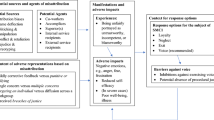Abstract
The fast-growing category of defamation lawsuits in the United States involves actions by employees against their employers. Over the last decade, the courts have increasingly ruled in favor of the employee plaintiffs, thus creating an employee's right to reputation. This article identifies a variety of responses undertaken by organizations to reduce their legal liability and lessen the likelihood of employee defamation lawsuits. We argue that while organizational actions to reduce their legal liability may appear “rational,” such responses may also be creating situations in which employers, employees, and the public may be the unintended victims of a “law without justice.” The article concludes with a discussion of balancing the freedom necessary for managers to communicate about employees and the fairness of that communication.
Similar content being viewed by others
References
Bies, R. J. (1992).The manager as intuitive politician: Blame management in the delivery of bad news. Manuscript under review.
Bies, R. J., & Moag, J. S. (1986). Interactional justice: Communication criteria of fairness. In Lewicki, R. J., Sheppard, B. H., & Bazerman, M. H. (Eds.),Research on Negotiation in Organizations (Vol. 1, 53–55). Greenwich, CT: JAI Press.
Bies, R. J., & Tyler, T. R. (1993). The “litigation mentality” in organizations: A test of alternative psychological explanations.Organization Science, 4, 352–366.
Brockner, J., & Greenberg, J. (1990). The impact of layoffs on survivors: An organizational justice perspective. In Carroll, J. (Ed.),Applied social psychology and organizational settings (45–75). Hillsdale, NJ: Lawrence Erlbaum Associates.
Buffolino v. L. I. Savings Bank, 2 IER Cases 895 (1987).
Cassin, R. L. (1985), December). Careless whispers: When communication is defamation.Management World, 14, 30–32.
Catagnera-Cain, J. (1987). Defamation and invasion of privacy actions in typical employee relations situations.Lincoln Law Review, 13, 1–19.
Davis v. Ross, 754 F. 2d 80 (2. Circ. 1985).
Dun & Bradstreet v Greenmoss Builders, Inc., 105 S. Ct. 2939 (1985).
Eades, R. W. (1986). The school counselor or psychologist and problems of defamation.Journal of Law & Education, 15, 117–120.
Folger, R., & Bies, R. J. (1989). Managerial responsibilities and procedural justice.Employee Responsibilities and Rights Journal, 2, 79–90.
Green, R. M., & Reibstein, R. J. (1988).Negligent Hiring, Fraud, Defamation, and Other Areas of Employer Liability, Washington, DC: Bureau of National Affairs.
Hall v. Buck, 678 S. W. 2d 612 (1984).
Hamilton, A. J., & Usry, M. L. (1990), October–December). Small business alert: New development in defamation law.Business, 40, 25–27.
Jacobs, R. B. (1989). Defamation and negligence in the workplace.Labor Law Journal, 40, 567–574.
Lammers, T. (1989, June). By the numbers: The new arithmetic of reference giving.Inc., 11, 137.
Langdon, C. W., & Galle, W. P. (1989, August). “... And what was the reason for your departure?”Personnel Administrator, 34, 632–670.
Langvardt, A. W. (1990, September/October). Defamation in the business setting: Basics and practical perspectives.Business Horizons, 33, 66–79.
Larson, R. J. (1987). Defamation in the workplace: Employers beware.Hofstra labor Law Journal, 5, 45–65.
Lewis, J. B., Ottley, B. L., & Mersol, G. V. (1989). Defamation and the workplace: A survery of the law and proposals for reform.Missouri Law Review, 54, 797–870.
Lewis v. Equitable Life Assurance Society of the United States, 389 N. W. 2d 876 (Minn. 1986).
McClandless, S. R., & Lofholm, D. (1987, Summer). False and defamatory.The Brief, 12–15+.
Marshall v. Brown, 190 Cal. Rptr 392 (Cal. 1983).
Martin, D. C., & Bartol, K. M. (1987). Potential libel and slander issues involving discharged employees.Employee Relations Law Journal, 13, 43–60.
Mintzberg, H. (1973).The Nature of Managerial Work. Englewood Cliffs, NJ: Prentice-Hall.
Murphy, B. S., Barlow, W. E., & Hutch, D. D. (1991, September). Job reference liability of employers.Personnel Journal, 22.
Nobile, R. J. (1990, October). Termination and defamation.Personnel, 67, 19.
Novit, M. S. (1982, April-June). Defamation: Management's new predicament.Business, 2–7.O'Brien v. Papa Gino's, 1 IER Cases 459 (1986).
Ottley, B. L. (1987, November 11). Workplace growing source of suits.Chicago Daily Law Bulletin, 133, 2.
Pozgar, G. D. (1986, January).On the grapevine.Health Care Supervisor, 4, 39–49.
Prentice, R. A., & Winslett, B. J. (1987). Employee references: Will a “no comment” policy protect employers against liability for defamation?American Business Law Journal, 25, 207–239.Second Restatement of Torts. (1977).
Ryan, A. M., & Lasek, M. (1991). Negligent hiring and defamation: Areas of liability related to pre-employment inquiries.Personnel Psychology, 44, 293–319.
Sack, S. M. (1987, February). Defamation: A sales force liability.Small Business Report, 12, 78.
Shearer, R. A. (1990). The self-publication doctrine: Expanding employer defamation liability.Employee Relations Law Journal, 16, 57–66.
Siefert v. El Paso Natural Gas Co., 567 S. W. 2d 77 (1978).
Sitkin, S. B., & Bies, R. J. (1993). The legalistic organization: Definitions, dimensions, and dilemmas.Organization Science, 4, 345–351.
Stevens, G. E. (1983). Constitutional privilege and the college tenure committee.American Business Law Journal, 21, 351–361.
Stevens, G. E. (1984). Negligent misrepresentation in employee counseling.Employee Relations Law Journal, 10, 276–285.
Stricharchuk, G. (1986, October 2). Fired employees turn the reason for dismissal into a legal weapon.The Wall Street Journal, 33.
Tidwell, J. A. (1986). Educator's liability for negative letters of recommendation.Journal of Law & Education, 15, 479–483.
True v. Ladner, 513 A. 2d 257 (Me. App. 1986).
Turner, R. (1988). Compelled self-publication: How discharge begets defamation.Employee Relations Law Journal, 14, 19–29.
Wagner v. Caprock Beefpackers Company, 540 S.W. 2d 303 (1976).
White, C. S., & Kleiman, L. S. (1991, August). The cost of candid comments,HR Magazine, 36, 54–56.
Author information
Authors and Affiliations
Rights and permissions
About this article
Cite this article
Bies, R.J., Tripp, T.M. Employee-initiated defamation lawsuits: Organizational responses and dilemmas. Employ Respons Rights J 6, 313–324 (1993). https://doi.org/10.1007/BF01385020
Issue Date:
DOI: https://doi.org/10.1007/BF01385020




